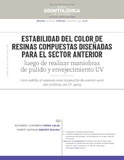Mostrar el registro sencillo del ítem
Estabilidad del color de resinas compuestas diseñadas para el sector anterior luego de realizar maniobras de pulido y envejecimiento UV
| dc.rights.license | http://creativecommons.org/licenses/by-nc-sa/3.0/ve/ | es_VE |
| dc.contributor.author | Parra Salas, Ruthmary Coromoto | |
| dc.contributor.author | Ramírez, Robert | |
| dc.date.accessioned | 2022-08-10T15:23:02Z | |
| dc.date.available | 2022-08-10T15:23:02Z | |
| dc.date.issued | 2022-08-10 | |
| dc.identifier.issn | 1856-3201 | es |
| dc.identifier.uri | http://www.saber.ula.ve/handle/123456789/48365 | |
| dc.description.abstract | Las resinas compuestas son de uso frecuente en Odontología Restauradora, especialmente cuando la estética adquiere importancia. Se realizó un estudio experimental, longitudinal y comparativo con el objetivo de establecer diferencias en la estabilidad del color de diferentes tipologías de resinas compuestas: nanorelleno, microhíbrida y nanohíbrida pulidas con dos sistemas de acabado y pulido: (gomas vs. discos), en tres diferentes momentos: pre-pulido, post-pulido y envejecimiento ultravioleta (UV). Se realizaron 8 probetas de tres resinas compuestas: Filtek Z350® (Z350), TetricNceram® (TNC) y BrilliantEnamel® (BE), aleatoriamente se subdividieron en dos grupos para someterlas a los siguientes sistemas de pulido (SP): Jiffy® (J) y Super Snap® (SS). Se determinó el color con escala CIEL*a*b* en tres momentos (M), Pre-pulido1, Post-pulido2 y Envejecidas Uva3. En el análisis estadístico se utilizó ANOVA de mediciones repetidas para las comparaciones múltiples, la prueba de HSD Tukey en los efectos inter-sujetos y Bonferroni para intra-sujetos, valor p= 0,05. Los resultados obtenidos mostraron HSD Tukey: M1:Z350 ?E 70,2 (0,9) >TNC ?E 66,6 (0,8) = BE ?E 65,7 (0,9). M2:Z350 ?E 70,8 (1,1) > TNC ?E 66,6 (1) = y BE ?E 66,4 (0,4). M3: Z350 ?E 68,6 (0,7) = TNC ?E 68,3 (2,4) >BE ?E 64 (1,2). SP: p= 0,05 sin diferencias estadísticas significativas. Bonferroni: M2 ?E 67,9 (2,2) >M1 ?E 67,5 (2,2) = M3 ?E 67 (2,7). Se concluyó que bajo las condiciones en que se realizó esta investigación la estabilidad del color de las resinas probadas es independiente del sistema de acabado y pulido. El envejecimiento acelerado ultravioleta (UV) produce cambios en el color y en la superficie de las muestras haciéndolas más rugosas y cromáticas. Sin embargo, la presencia de pre-polímeros en TNC parece mejorar la estabilidad. | es_VE |
| dc.language.iso | es | es_VE |
| dc.rights | info:eu-repo/semantics/openAccess | es_VE |
| dc.subject | resinas compuestas | es_VE |
| dc.subject | pulido dental | es_VE |
| dc.subject | ensayo de materiales | es_VE |
| dc.subject | color | es_VE |
| dc.subject | colorimetría | es_VE |
| dc.title | Estabilidad del color de resinas compuestas diseñadas para el sector anterior luego de realizar maniobras de pulido y envejecimiento UV | es_VE |
| dc.title.alternative | Color stability of composite resins designed for the anterior sector after polishing and UV ageing | es_VE |
| dc.type | info:eu-repo/semantics/article | es_VE |
| dcterms.dateAccepted | 06/04/2020 | es |
| dcterms.dateSubmitted | 28/10/2019 | es |
| dc.description.abstract1 | Composites resins are most frequently used materials in Restorative Dentistry especially when the aesthetic effect becomes important. An experimental design study was carried out, with a longitudinal cut and a comparative type with the aim of establishing differences in color stability of different types of composite resins: nano-filler, micro-hybrid and nano-hybrid, polished with two finishing and polishing systems: (rubber vs. discs), at three different times: pre-olishing, post-polishing and ultraviolet (UV) aging. Eight specimens were made of three composite resins Filtek Z350® (Z350), TetricNceram® (TNC) and BrilliantEnamel® (BE). Randomly subdivided into two groups to be submitted to the following systems of polished (SP): Jiffy ® (J) and Super Snap® (SS). Color was determined using the CIEL*a*b* scale at three stages, Pre-polishing1, Post-polishing2, and Uv Aging3. For statistical analysis was used a repeated measures ANOVA, for multiple comparisons of Tukey HSD test for inter-subjects effects and Bonferroni for significance, p=0.05 value. The results showed HSD Tukey: 70,2 ?E M1:Z350 (0.9) > TNC ?E 66.6 (0.8) = BE ?E 65.7 (0.9). M2:Z350 ?E 70.8 (1.1) > = TNC ?E 66.6 (1) and BE ?E 66.4 (0.4). M3: 68.6 ?E Z350 (0.7) = TNC ?E 68.3 (2,4) > BE ?E 64 (1,2). SP: p= 0.05 no significant statistical differences. Bonferroni: M2 ?E 67.9 (2.2) > ?E 67.5 (2.2) M1 = M3 ?E 67 (2.7). It was concluded that under the conditions in which this research was carried out the color stability of the resins tested is independent of the finishing and polishing system. Accelerated ultraviolet (UV) aging produces changes in the color and surface of the samples making them rougher and more chromatic. However, the presence of pre-polymers in TNC appears to improve stability. | es_VE |
| dc.description.colacion | 48—66 | es_VE |
| dc.description.email | od.ruthparra@gmail.com | es_VE |
| dc.description.email | revodontdlosandes@gmail.com | es_VE |
| dc.description.frecuencia | Semestral | es |
| dc.description.paginaweb | http://erevistas.saber.ula.ve/odontoula | es |
| dc.identifier.depositolegal | pp-200502ME2052 | es |
| dc.publisher.pais | Venezuela | es_VE |
| dc.subject.facultad | Facultad de Odontología | es_VE |
| dc.subject.institucion | Universidad de Los Andes | es_VE |
| dc.subject.keywords | composite resins | es_VE |
| dc.subject.keywords | dental polishing | es_VE |
| dc.subject.keywords | materials testing | es_VE |
| dc.subject.keywords | color | es_VE |
| dc.subject.keywords | colorimetry | es_VE |
| dc.subject.seccion | Revista Odontológica de Los Andes: Trabajos de Investigación | es_VE |
| dc.subject.tipo | Revistas | es_VE |
| dc.type.media | Texto | es_VE |
Ficheros en el ítem
Este ítem aparece en la(s) siguiente(s) colección(ones)
-
Revista Odontológica de Los Andes - Vol. 015 - Nº 1
Enero - Junio 2020


